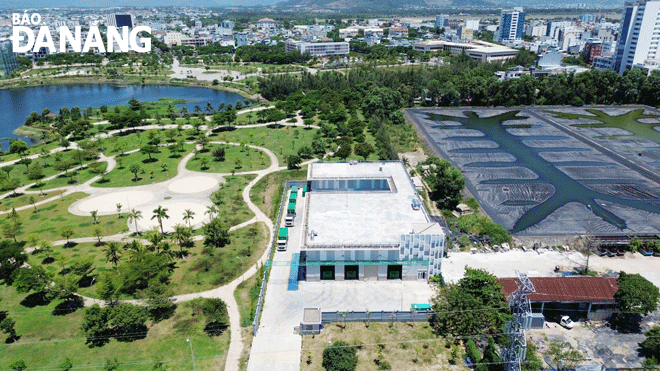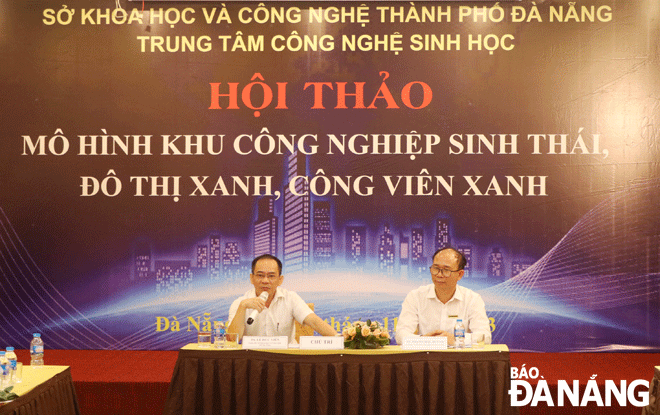Da Nang develops eco-industrial parks and green urban areas
At the workshop ‘Model of eco-industrial parks, green urban areas, green parks’ organised by the Department of Science and Technology on Wednesday. State management agencies, scientists, and researchers contributed many opinions, share, and complete the model and set of evaluation criteria, thereby contributing to building Da Nang into an environmentally-friendly livable city, an ecological urban area with green and sustainable growth.
 |
| According to Decision No. 1287 dated November 2, 2023 of the Prime Minister approving Da Nang Planning for the 2021 - 2030 period period, with a vision towards 2050, setting the goal of becoming an ecological, modern and smart urban area. A corner of Da Nang viewed from above. Photo: VAN HOANG |
Inevitable trend
According to Director of the Department of Science and Technology Le Duc Vien, after 10 years of implementing the goals of building an environmentally-friendly city, Da Nang will continue to approve the project ‘Building Da Nang into an Environmentally-friendly City’ in the 2021 - 2030 period, with a focus on developing Da Nang into an environmentally-friendly livable city, an ecological urban area with green and sustainable growth.
This is considered a consistent goal in the city's development orientation and is always determined not to trade off the environment to achieve economic goals. Recently, Decision No. 1287/QD-TTg dated November 2, 2023 of the Prime Minister approving the Da Nang Planning for the 2021-2030 period, with a vision towards 2050, aiming to building Da Nang into an ecological, modern and smart urban area.
To achieve that, urban areas and residential areas must ensure green - clean - beautiful; industrial clusters and parks (IZs) must be green, ecological industrial parks to head towards building circular economy according to the goal of NET Zero (cutting greenhouse gas emissions to zero).
According to the Centre for Biotechnology, for the ‘Green Urban’ model in Da Nang, the development is based on 4 important factors including energy efficiency, renewable energy in all fields; widespread greening; compact development in planning with mixed land use/social harmony; principles of green and equitable growth. Among them, renewable energy and energy efficiency in all urban activities are the most important starting points for green cities. Energy is linked to many elements of green urban development. This is also a central factor to promote and direct the achievement of efficient resource use, contributing to overall urban improvement.
On the other hand, widespread greening in sectors is associated with the idea of bringing nature back to urban areas. The main goals of green growth are to reduce the intensity of greenhouse emissions per GDP, greening economic sectors, greening lifestyles and promoting sustainable consumption, greening the transition process on the principle of equality and improving resilience.
For the ‘eco-industrial park’ model, it will impact the economy, environment and society, leading to the creation of value for stakeholders in eco-industrial parks. Above all, geographical conditions play an important role in construction and development, with a special heed to infrastructure, a factor that goes ahead and paves the way to develop eco-industrial parks.
The parts of the eco-industrial park ensure the movement of material flows (materials, energy, water, waste...) in the industrial park, taking place according to the economic cycle to improve efficiency of the use of materials and recycle and reuse waste.
In the model, the issue of industrial symbiosis needs to be paid attention and focused, ensuring legal factors, awareness of participating parties, trust in partners, feasible and appropriate technology, and financial resources.
 |
| The Da Nang Department of Science and Technology organised a workshop ‘Model of ecological industrial parks, green urban areas, green parks’ on November 15. Photo: VAN HOANG |
Many problems need to be resolved
According to the Da Nang Department of Environmental Management, Science - Technology and Incubation, the Authority of the Da Nang Hi-Tech Park and Industrial Zones, there are 6 industrial parks in operation in the city.
Since 2015, the Ministry of Planning and Investment together with the United Nations Industrial Development Organization (UNIDO) has piloted the conversion of a number of conventional industrial parks in localities to eco-industrial park models, including Hoa Khanh Industrial Park located in Lien Chieu District.
Many businesses have participated and achieved certain achievements, including industrial symbiosis issues. Under the project ‘Building Da Nang into environmentally-friendly city’ for the 2021 - 2030 period, the city aims to complete the eco-industrial park model by 2025 and have 2-3 eco-industrial parks by 2030.
In the coming time, the Authority of Da Nang Hi-tech Park and Industrial Zones will develop a project and plan to convert industrial parks in the city into eco-industrial parks.
According to Mr. Le Duc Vien, eco-industrial parks need to be built on the foundation of ecological enterprises. Besides, the issue of industrial symbiosis is one of the important criteria when building ecological industrial parks. The above-mentioned two issues are very closely linked to businesses, so we need to be aware of the importance of building and developing ecological businesses.
Asso. Prof. Ph.D Tran Van Quang, a senior lecturer at the University of Science and Technology, a member school of the University of Da Nang, acknowledged that the criteria for building and developing the model need to be consistent with the city's reality.
In eco-industrial parks, infrastructure is an important factor that needs to be deployed first, while in the context of the city's industrial parks, applying the criteria for building eco-industrial parks is very difficult. Therefore, it can be recommended to apply them in new industrial clusters in districts.
Similarly, Mr. Bui Duc Loi, CEO of Hoa Cam Industrial Park Investment Joint Stock Company, said that building an ecological industrial park is a very difficult problem. Currently, most industrial parks are full of space and there are many problems when converting, so units need to develop a suitable roadmap and assess the current situation of industrial parks in the city.
At the same time, it is necessary to clearly identify the benefits of investors when building eco-industrial parks.
Ph.D architect Le Phong Nguyen, the Head of Planning Department, Faculty of Architecture, the University of Science and Technology also said that criteria and models need to be based on the database and local context. For example, the construction of the "Green Park" model needs to be considered from clear practical requirements, the scope of use, needs, habits, and usage time of people, thereby making an overall assessment to build a set of specific and clear construction criteria.
Reporting by VAN HOANG - Translating by A.THU







